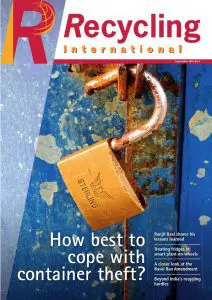Page 40 from: September 2014

40 September 2014
Everybody has seen the photos that have gone around the world of an Asian toddler
sitting on the ground amid landfilled piles of
e-scrap, and African children burning compu-
ter wiring to extract copper. Looking at these
pictures, one cannot but feel outrage.
The Basel Ban Amendment prohibits all
exports of materials legally defined as hazard-
ous wastes under the Basel Convention from
countries that are members of the EU or the
OECD to countries that are not members of
these organisations. It has been celebrated as a
major success in preventing the use of develop-
ing countries as cheap disposal options for
hazardous wastes, and irresponsible recycling
at the expense of poor people with no alterna-
tive but to risk their health in order to make a
living. There are, however, a number of mis-
conceptions surrounding the Ban Amendment.
Factually inaccurate
There is a widespread belief that the Basel Con-
vention, through the Ban Amendment, prohibits
the export of all UEPs from OECD to non-OECD
countries, regardless of what is being traded for
what purpose. This is factually inaccurate.
For one thing, although the Ban Amendment
enjoys some political support, it is not in force;
therefore, it is not a binding part of the Basel
Convention and does not constitute interna-
tional law. If and when the Ban enters into
force, it will be legally binding only on those
countries that have ratified it. A fair number of
Basel parties – including not only non-Europe-
an industrialised nations such as the USA and
Canada, but also some developing countries –
do not support the Ban Amendment and are
unlikely ever to ratify it, although they are
much less vocal than the supporters of the Ban.
For another thing, the Basel Convention does
not apply to all UEP shipments, but only to
those considered hazardous wastes. For exam-
ple, commodities recycled from UEPs – such as
steel, aluminium, copper, circuit boards, proc-
essed glass and most plastics – are largely trad-
ed around the world as non-hazardous ship-
ments. These exports are overwhelmingly seen
as non-problematic.
Conversely, there is little disagreement that
unprocessed UEPs containing substances such
as mercury, cadmium and polychlorinated
biphenyls, which exhibit hazardous character-
istics and are exported for disposal, are classified
as hazardous shipments under the Basel Con-
vention. Also, there is no universally accepted
definition of hazardous UEPs: the Basel Con-
vention leaves room for interpretation, and
accordingly different countries around the
world have different definitions. The best exam-
ple is UEPs moved across borders for repair and
refurbishment: some countries suggest all such
L E G I S L A T I O N By Katharina Kummer Peiry
The Ban Amendment under the Basel Convention, the global treaty controlling transboundary movement
of hazardous wastes and their disposal, has given rise not only to deep emotions but also to misconcep-
tions. In this article, an undisputed expert in this complex field looks to sort fact from fiction.
The Basel Ban Amendment:
myths and facts
In practice, it can be diffi cult to distinguish which shipments are
hazardous and which are not.
RI-7 Basel Convention.indd 40 01-09-14 09:20



